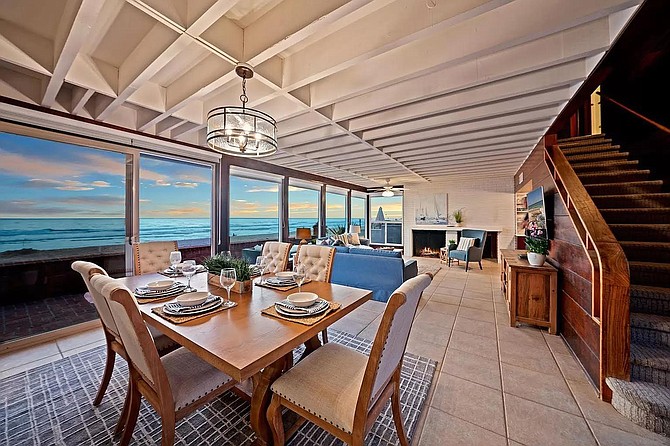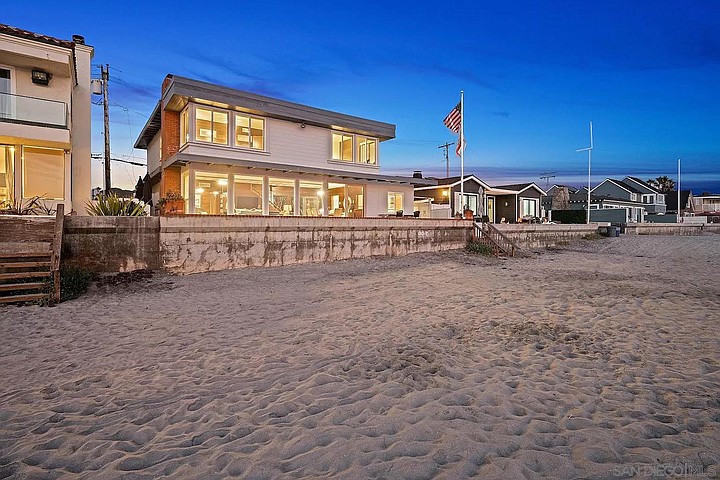 Facebook
Facebook
 X
X
 Instagram
Instagram
 TikTok
TikTok
 Youtube
Youtube

Frank Hope Sr. was a World War I veteran and UC Berkeley dropout when he came to San Diego to work for the esteemed architectural firm Requa & Jackson. By 1928, he had struck out on his own and formed Frank L. Hope and Associates, designing homes and churches in a Mediterranean style he picked up from Requa before moving to the coast and adopting a modernist Art Deco aesthetic.
Some of Hope’s more notable designs included Our Lady of Guadalupe Catholic Church in Logan Heights and the Great Western Bank tower downtown. After he passed the company on to his son, the firm picked up more notable commercial work, including the aquarium at Scripps Institution of Oceanography and SDCCU, nee Qualcomm, nee Jack Murphy, nee San Diego Stadium. Though derided as dated and functionally lacking as early as the 1990s by its baseball and football tenants, the Brutalist coliseum won several design awards when it opened in 1967.

Let’s take a look at the home Hope built for himself in 1946, a 2462-square-foot beach bungalow at 2312 Ocean Front in northern Del Mar. “Relax and rejuvenate as the sun shines and the waves crash on one of the finest white sand beaches in all of Southern California,” the opening of the property’s Zillow listing invites prospective buyers. But what of the house? From the street, there’s not really much to see. Google Maps leaves us standing in an alley paved with asphalt of questionable condition, the home mostly obscured on this side, though there is a window poking out of what looks like it was once a garage. On the other side of the alley is a two-car garage and a driveway with some extra parking. It’s easy to see why these photos were left off the listing.
Once we’re past the front gate, however, things start looking up. There’s a pleasant shaded brick courtyard with a large teak outdoor dining set and barbecue area, along with a cozy-looking seating area. And once inside, we’ll pass a beautiful and rich wood staircase that I wish got its own picture rather than the quick glance we get in the corner of a shot highlighting the oceanfront dining room. The ceilings are all coffered beam and have been painted white. Normally, it would be nice to see the original wood, but many of the walls retain their wood paneling, which lends a mid-century sensibility to the interior. The dining area is open to the living room, which offers a fireplace and wet bar. Beyond is the kitchen, which, compared to other multimillion-dollar residences, seems rather spartan in its narrow galley-style configuration. There is, at least, an opening in the wall to the dining area, and a window that serves as a pass-through to the open air bar on the back oceanfront deck. The base cabinets, while simple, are painted a friendly blue that goes well with an interesting seashell-scalloped backsplash.
Upstairs, the four bedrooms are just fine, but there’s nothing special to see. We also get a shot of the attached “family room,” which functions as a studio with its own kitchen. Steps down from raised foundation to slab level seem to confirm that this was likely once a garage.
Although the house is nice, what we’re really buying here is 50 feet of prime oceanfront property, where a quick hop over the seawall has you sitting on the prime piece of sand mentioned in the listing. Another brick patio extends right to the beach’s edge, granting great access to summer people-watching and, as the listing boasts, “exquisite sunsets.”
Public records list a Williams family trust as the home’s current owner. It’s not currently owner occupied, and has been offered for rent in recent years for as much as $10,000 per month during the Del Mar racing season, when wealthy out-of-towners flock to the horse track just north of the beach. The county assessor values the property at just under $250,000, meaning it’s been quite a while since it’s changed hands.
Hope’s Ocean Front estate was first listed for sale in early August, its asking price of $13,950,000 remains unchanged to date.


Frank Hope Sr. was a World War I veteran and UC Berkeley dropout when he came to San Diego to work for the esteemed architectural firm Requa & Jackson. By 1928, he had struck out on his own and formed Frank L. Hope and Associates, designing homes and churches in a Mediterranean style he picked up from Requa before moving to the coast and adopting a modernist Art Deco aesthetic.
Some of Hope’s more notable designs included Our Lady of Guadalupe Catholic Church in Logan Heights and the Great Western Bank tower downtown. After he passed the company on to his son, the firm picked up more notable commercial work, including the aquarium at Scripps Institution of Oceanography and SDCCU, nee Qualcomm, nee Jack Murphy, nee San Diego Stadium. Though derided as dated and functionally lacking as early as the 1990s by its baseball and football tenants, the Brutalist coliseum won several design awards when it opened in 1967.

Let’s take a look at the home Hope built for himself in 1946, a 2462-square-foot beach bungalow at 2312 Ocean Front in northern Del Mar. “Relax and rejuvenate as the sun shines and the waves crash on one of the finest white sand beaches in all of Southern California,” the opening of the property’s Zillow listing invites prospective buyers. But what of the house? From the street, there’s not really much to see. Google Maps leaves us standing in an alley paved with asphalt of questionable condition, the home mostly obscured on this side, though there is a window poking out of what looks like it was once a garage. On the other side of the alley is a two-car garage and a driveway with some extra parking. It’s easy to see why these photos were left off the listing.
Once we’re past the front gate, however, things start looking up. There’s a pleasant shaded brick courtyard with a large teak outdoor dining set and barbecue area, along with a cozy-looking seating area. And once inside, we’ll pass a beautiful and rich wood staircase that I wish got its own picture rather than the quick glance we get in the corner of a shot highlighting the oceanfront dining room. The ceilings are all coffered beam and have been painted white. Normally, it would be nice to see the original wood, but many of the walls retain their wood paneling, which lends a mid-century sensibility to the interior. The dining area is open to the living room, which offers a fireplace and wet bar. Beyond is the kitchen, which, compared to other multimillion-dollar residences, seems rather spartan in its narrow galley-style configuration. There is, at least, an opening in the wall to the dining area, and a window that serves as a pass-through to the open air bar on the back oceanfront deck. The base cabinets, while simple, are painted a friendly blue that goes well with an interesting seashell-scalloped backsplash.
Upstairs, the four bedrooms are just fine, but there’s nothing special to see. We also get a shot of the attached “family room,” which functions as a studio with its own kitchen. Steps down from raised foundation to slab level seem to confirm that this was likely once a garage.
Although the house is nice, what we’re really buying here is 50 feet of prime oceanfront property, where a quick hop over the seawall has you sitting on the prime piece of sand mentioned in the listing. Another brick patio extends right to the beach’s edge, granting great access to summer people-watching and, as the listing boasts, “exquisite sunsets.”
Public records list a Williams family trust as the home’s current owner. It’s not currently owner occupied, and has been offered for rent in recent years for as much as $10,000 per month during the Del Mar racing season, when wealthy out-of-towners flock to the horse track just north of the beach. The county assessor values the property at just under $250,000, meaning it’s been quite a while since it’s changed hands.
Hope’s Ocean Front estate was first listed for sale in early August, its asking price of $13,950,000 remains unchanged to date.